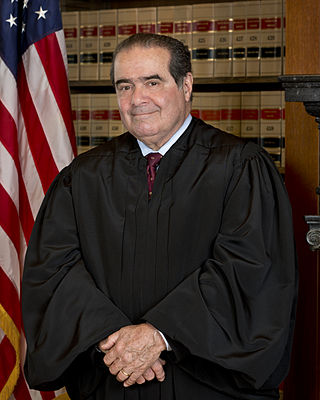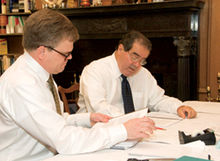
Antonin Gregory Scalia was an American jurist who served as an associate justice of the Supreme Court of the United States from 1986 until his death in 2016. He was described as the intellectual anchor for the originalist and textualist position in the U.S. Supreme Court's conservative wing. For catalyzing an originalist and textualist movement in American law, he has been described as one of the most influential jurists of the twentieth century, and one of the most important justices in the history of the Supreme Court. Scalia was posthumously awarded the Presidential Medal of Freedom in 2018, and the Antonin Scalia Law School at George Mason University was named in his honor.
Legal formalism is both a descriptive and normative theory of how judges should decide cases. In its descriptive sense, formalists maintain that judges reach their decisions by applying uncontroversial principles to the facts; formalists believe that there is an underlying logic to the many legal principles that may be applied in different cases. These principles, they claim, are straightforward and can be readily discovered by anyone with some legal expertise. Supreme Court Justice Oliver Wendell Holmes Jr., by contrast, believed that "The life of the law has not been logic: it has been experience". The formalist era is generally viewed as having existed from the 1870s to the 1920s, but some scholars deny that legal formalism ever existed in practice.

Originalism is a legal theory that bases constitutional, judicial, and statutory interpretation of text on the original understanding at the time of its adoption. Proponents of the theory object to judicial activism and other interpretations related to a living constitution framework. Instead, originalists argue for democratic modifications of laws through the legislature or through constitutional amendment.
In the United States, strict constructionism is a particular legal philosophy of judicial interpretation that limits or restricts the powers of the federal government only to those expressly, i.e., explicitly and clearly, granted to the government by the United States Constitution. While commonly confused with textualism or originalism, they are not the same, and in fact frequently contradict, as textualists like Antonin Scalia have noted.
Doe v. Chao, 540 U.S. 614 (2004), is a decision by the United States Supreme Court that interpreted the statutory damages provision of the Privacy Act of 1974.
In law, the legislative intent of the legislature in enacting legislation may sometimes be considered by the judiciary to interpret the law. The judiciary may attempt to assess legislative intent where legislation is ambiguous or does not appear to directly, adequately address a particular issue, or appears to have been a legislative drafting error.
Statutory interpretation is the process by which courts interpret and apply legislation. Some amount of interpretation is often necessary when a case involves a statute. Sometimes the words of a statute have a plain and a straightforward meaning. But in many cases, there is some ambiguity in the words of the statute that must be resolved by the judge. To find the meanings of statutes, judges use various tools and methods of statutory interpretation, including traditional canons of statutory interpretation, legislative history, and purpose. In common law jurisdictions, the judiciary may apply rules of statutory interpretation both to legislation enacted by the legislature and to delegated legislation such as administrative agency regulations.
Original intent is a theory in law concerning constitutional and statutory interpretation. It is frequently used as a synonym for originalism; while original intent is one theory in the originalist family, it has some salient differences which has led originalists from more predominant schools of thought such as original meaning to distinguish original intent as much as legal realists do.

The Living Constitution, or judicial pragmatism, is the viewpoint that the U.S. constitution holds a dynamic meaning even if the document is not formally amended. The Constitution is said to develop alongside society's needs and provide a more malleable tool for governments. The idea is associated with views that contemporary society should be considered in the constitutional interpretation of phrases. The Constitution is referred to as the living law of the land as it is transformed according to necessities of the time and the situation. Some supporters of the living method of interpretation, such as professors Michael Kammen and Bruce Ackerman, refer to themselves as organicists.
The plain meaning rule, also known as the literal rule, is one of three rules of statutory construction traditionally applied by English courts. The other two are the "mischief rule" and the "golden rule".
Textualism is a formalist theory in which the interpretation of the law is based exclusively on the ordinary meaning of the legal text, where no consideration is given to non-textual sources, such as intention of the law when passed, the problem it was intended to remedy, or significant questions regarding the justice or rectitude of the law.

Bryan Andrew Garner is an American legal scholar and lexicographer. He has written more than two dozen books about English usage and style such as Garner's Modern English Usage for a general audience, and others for legal professionals. Garner also wrote two books with Justice Antonin Scalia: Making Your Case: The Art of Persuading Judges (2008) and Reading Law: The Interpretation of Legal Texts (2012). He is the founder and president of LawProse Inc.

John Francis Manning is an American legal scholar who serves as the provost of Harvard University. He is the Dane Professor of Law at Harvard Law School (HLS), where he is a scholar of administrative and constitutional law. From 2017 to 2024, he was the 13th Dean of Harvard Law School.
The purposive approach is an approach to statutory and constitutional interpretation under which common law courts interpret an enactment within the context of the law's purpose.
Zadvydas v. Davis, 533 U.S. 678 (2001), was a case decided by the Supreme Court of the United States. The court ruled that the plenary power doctrine does not authorize the indefinite detention of immigrants under order of deportation whom no other country will accept. To justify detention of immigrants for a period longer than six months, the government was required to show removal in the foreseeable future or special circumstances.
Church of the Holy Trinity v. United States, 143 U.S. 457 (1892), was a decision of the Supreme Court of the United States regarding an employment contract between the Church of the Holy Trinity, New York and an English Anglican priest.

Judicial interpretation is the way in which the judiciary construes the law, particularly constitutional documents, legislation and frequently used vocabulary. This is an important issue in some common law jurisdictions such as the United States, Australia and Canada, because the supreme courts of those nations can overturn laws made by their legislatures via a process called judicial review.

Amy Vivian Coney Barrett is an American lawyer and jurist serving since 2020 as an associate justice of the Supreme Court of the United States. The fifth woman to serve on the court, she was nominated by President Donald Trump. Barrett was a U.S. circuit judge on the U.S. Court of Appeals for the Seventh Circuit from 2017 to 2020.
Bostock v. Clayton County, 590 U.S. 644 (2020), is a landmark United States Supreme Court civil rights decision in which the Court held that Title VII of the Civil Rights Act of 1964 protects employees against discrimination because of sexuality or gender identity.
Niz-Chavez v. Garland, 593 U.S. 155 (2021), was an immigration decision by the United States Supreme Court. In a 6–3 decision authored by Neil Gorsuch, the Court ruled against the federal government, holding that deportation hearing notices need to be in a single document. Although a highly technical case, the decision received attention for being predicated on the single-letter word a.








